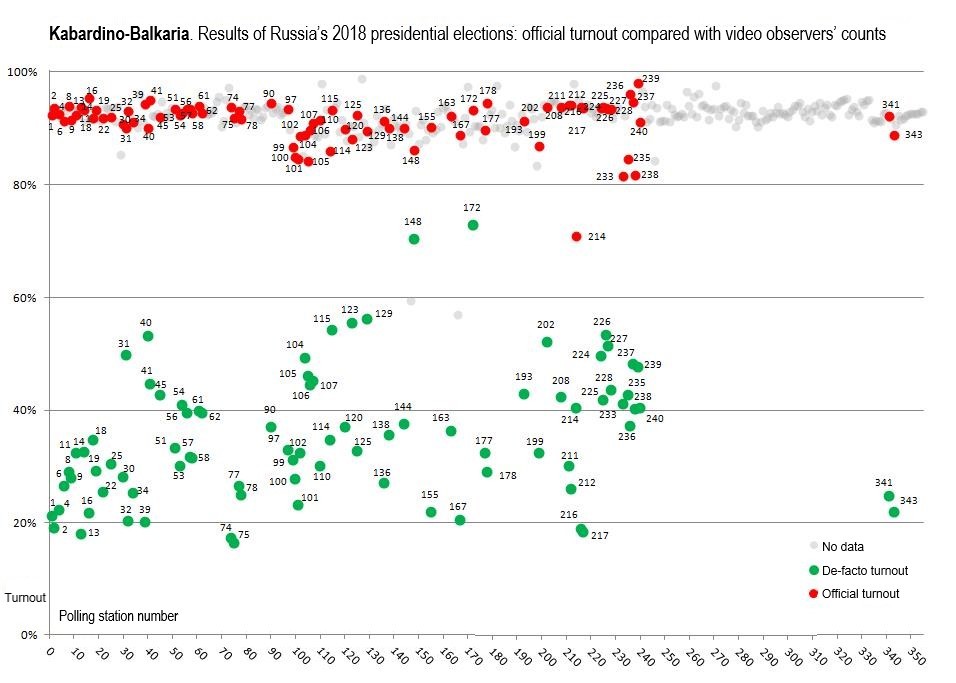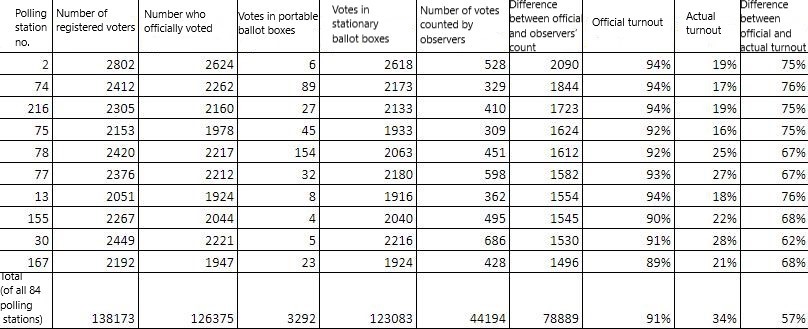March 18 marked a year since Russia’s last presidential election. Vladimir Putin allegedly won 76.69% of the vote, on a turnout of 67.54% (or 51.7% of all Russia’s eligible voters.) But a recent study of video recordings from polling stations paints quite a different picture of Putin’s latest “triumphal victory,” indicating that the official results were far from reality.
The main task of Putin’s team during the presidential election was to get him the support of an absolute majority, by whatever means necessary. Enormous administrative resources and media coverage were mobilised to achieve that goal, and people were convinced or coerced in various ways to show up and vote. But even these efforts to mobilise voters were insufficient. In many regions, the authorities had to rely on direct falsifications of the voting results. In some cases, ballot papers were not even counted; previously agreed numbers were given as results instead. In others, members of the electoral commission dumped hundreds of ballot papers into the ballot boxes themselves. Even the presence of video cameras at polling stations did not faze these election riggers.
When it comes to organising video livestreams from polling stations, Russia is particularly advanced. Attempts to broadcast the vote have been made in Armenia, Azerbaijan, Moldova, and Ukraine as well as several African countries. Online monitoring of polling stations was seriously discussed in Poland, but in the end the idea was postponed until future elections. At the same time, even in countries where the practice has taken root, broadcasts are generally of a poorer standard than those adopted in Russia.
During last year’s elections on March 18, video cameras were installed at 46,046 polling stations, which is where more than two thirds of Russia’s voters cast their ballots. Given the immense task of organising elections across Russia, this was decent coverage. Thanks to these video cameras, activists were able to watch the voting process online and immediately take note of any violations. However, Russian law enforcement agencies are usually very reluctant to take video recordings as sufficient evidence of a crime. Observers repeatedly appealed to investigators, but their requests to open criminal proceedings were almost always refused.
But what became of these important recordings? After voting had concluded, observers were denied the opportunity to access the recordings for further analysis. According to a procedure adopted by Russia’s Central Electoral Commission regulating access to its archives, only candidates have the right to request these video recordings. In response, several groups of observers who knew of this obstacle organised their own online “interception” of the broadcasts on election day. They managed to save video recordings from just over 8,000 polling stations spread across different regions of the country. And now, over a year later, volunteers are still independently watching the available videos and painstakingly counting how many people actually voted. Given that a thorough study of one video takes about seven or eight hours, volunteers have had to spend thousands of hours in order to piece together the real picture of voting in Russia’s polling stations.
In February, Golos (a civil society organisation defending voters’ rights — ed.) published a report detailing volunteers’ findings. It revealed an anomalously high number of votes counted (approximately 100,000) at 244 polling stations in five regions: Kemerovo Oblast, Krasnodar Krai, and the Republics of Dagestan, Karachai-Cherkessia, and Kabardino-Balkaria. According to the results of the analysis, the largest inflated turnout from among all the regions was found in Kabardino-Balkaria. The volunteers decided to turn their attention to recordings from polling stations in this North Caucasus region. What they discovered was astonishing: the falsifications they discovered prove that the “pro-Putin majority” was conjured up by members of the electoral commissions. These revelations put the legitimacy of the entire voting process into question.
At the time of writing, independent volunteers have studied video recordings from almost every fourth polling station in Kabardino-Balkaria (which amounts to 84 of the 354 polling stations which were opened in the region.) In none of these polling stations did the turnout as observed by volunteers match the official data. In some instances, members of the local electoral commission falsified results by several thousand votes. The average discrepancy for all the polling stations in question came to 939 voters. This means that every polling station in Kabardino-Balkaria provided Putin with approximately a thousand extra votes.
It should be mentioned that when it comes to voter turnout and share of the vote given to Putin, Kabardino-Balkaria ranks as one of the highest regions in the country. According to official figures, 484,560 of the republic’s 528,431 eligible voters took part in the election, meaning a turnout of 91.8%. Apparently 452,480 people in the republic (or 93.3% of all voters) supported Putin.
The graph below, which compares the official turnout with that recorded by observers who watched the video recordings, clearly shows two accounts of the results which do not correlate. On the one hand, we have the “red carpet” to power laid out by the staff of the electoral commissions, and on the other the “green path” representing how residents of the republic actually voted. In sum, observers found that 84,194 people voted in the 84 polling stations under scrutiny; this means that the actual turnout was 34.6% instead of the officially stated 91.8%. So, what accounts for the additional votes recorded in official data? There are two plausible answers: either members of the district electoral commissions simply inflated the numbers in their official reports, or they dumped additional papers in the ballot boxes themselves, seemingly unfazed before the video cameras.

Red: official turnout for polling stations under analysis
Green: turnout as counted by observers of video recordings from polling stations
Grey: other polling stations (not under analysis)
Therefore, if only slightly over a third of the region’s voters cast their ballots on the election day this means that in reality, only about 180,000 people voted in Kabardino-Balkaria (instead of the official figure of 484,000.) Consequently, two of every three votes for Putin were falsified. These conclusions can be easily drawn by extrapolating the results of a quarter of the polling stations under scrutiny.
Sergey Shpilkin’s method of electoral analysis is useful for revealing “anomalous” votes; according to his calculations, there were at 360,000 of them in Kabardino-Balkaria during the last presidential election. While taking into account that the observers of the video recordings were unable to verify the accuracy of final results themselves, the conclusions of the two different analytical methods still roughly coincide.
The data obtained from video observers is undoubtedly reliable. As several independent groups of volunteers were involved, most of the recordings from polling stations were checked twice. All these groups used the same methodology: they only counted those voters whom they observed dropping a ballot paper into the ballot box. Discrepancies between the results provided by the different observation teams do not amount to more than 10-15 votes, so are therefore insignificant in the overall statistical picture.
The electoral fraud organised by members of the electoral commissions of Kabardino-Balkaria undoubtedly merits a place in the official records. For example, while only 19% of eligible voters showed up at polling station number two, the official turnout was recorded as 94%. This meant an additional 2,090 votes.
Polling stations in Kabardino-Balkaria with the highest number of attributed votes(full table)

Some electoral commissions did not even bother to count the ballots deposited in the ballot boxes. Instead, they simply entered the “required” numbers in the record. One electoral commission in Nalchik, the capital of Kabardino-Balkaria, distinguished itself in this regard. The members of local electoral commission for precinct number 155 spent the whole day diligently dumping ballot papers into the ballot box. By the time voting closed, the official record indicated that 2,040 ballot papers were in the ballot box. Yet a count of voters by independent observers watching the video recording indicated that just 495 people had turned up to cast a vote. Thus the selfless members of the electoral commission took it upon themselves to choose on behalf of at least 1,500 people who did not even show up at the polling station.
Kabardino-Balkaria is generally counted among one of Russia’s so-called “electoral sultanates.” This term refers to regions of Russia where official election results, even by the standards of Russian elections, have no relationship to how local people voted. The list of these “sultanates” also includes the neighbouring North Caucasus republics of Karachai-Cherkessia, Chechnya, Ingushetia, Dagestan, and North Ossetia, the Siberian regions of Tuva and Kemerovo Oblast, the Republic of Mordovia, the Yamalo-Nenets Autonomous Okrug, and several other federal subjects. According to Shpilkin’s estimates, more than 10 million votes in the presidential election can be classed as “abnormal,” hence so must every fifth vote allegedly cast for Vladimir Putin. The lion’s share of these mysterious votes lies in the “electoral sultanates.” In effect, the illusion of mass nationwide support for the president is thanks to mass electoral fraud in these same regions.
Through the example of Kabardino-Balkaria, one region in the North Caucasus, independent observers of the video recordings have been able to prove just how fictitious these votes really are. In doing so, they have confirmed what electoral analysts have long since stated. This testifies to the value of independent volunteers, who spent hours and hours of their own time studying the archive of video recordings from Russia’s polling stations. Thanks to them, we know not only the scale of electoral fraud in Russia, but can determine the exact number of false votes and the names of those responsible.
And that is presumably why, on March 24, 2019, Russia’s Central Electoral Commission destroyed all the video recordings from polling stations during last year’s presidential elections.










